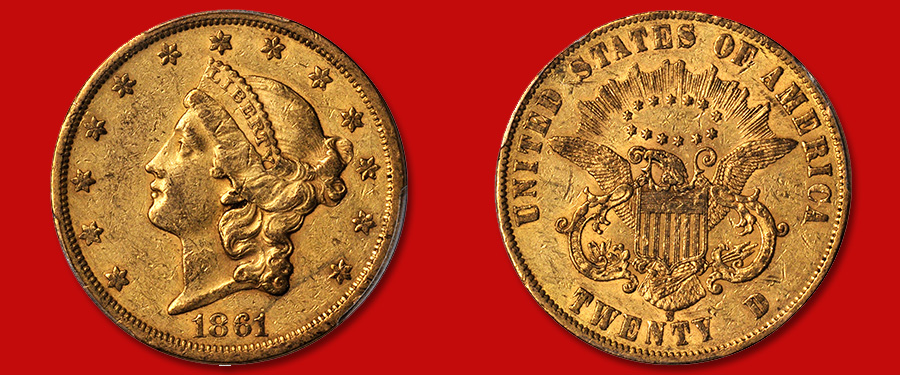
Our June 2018 Baltimore sale is fast approaching and among the stellar collections to be featured is the Fairmont Collection, a nearly complete set of Liberty Head double eagles. It is currently ranked as the second finest PCGS Set Registry in the Liberty Head $20 Gold with Major Varieties, Circulation Strikes (1850-1907) category. This fresh cabinet offers an exceptional selection of original and rare Liberty Head double eagles and will be a treat for any numismatist. One of the many highlights is a beautiful example of the 1861-S Paquet reverse $20 rarity, certified by PCGS as AU-53, and awarded a CAC sticker of approval.
Among the finest certified, this attractive and problem-free coin stands out, even among the highlights in the Fairmont Collection. Awash in rich honey-gold patina, the surfaces are original, a rare state for this elusive issue. Notable are pale rose highlights and ample remnants of a satiny mint finish. The strike is bold to sharp and the surfaces are remarkably smooth for the assigned grade. This is certainly one of the finest examples of the issue that we have ever handled.
Believed to be the son of bronze-worker Toussaint Francois Paquet, Anthony C. Paquet was born in Hamburg, Germany on December 5, 1814, and arrived in Philadelphia in 1848. In the mid-1850s, Paquet opened an engraving business in New York, during which time he is believed to have struck several medals, apparently all unsigned, except for THE ROCKY MOUNTAINS ECHO BACK FREMONT campaign medal. In early 1857, Paquet took up contract work for the Philadelphia Mint before finally being hired as an assistant engraver. His projects at the Mint were mostly pattern coins, once again unsigned, including a fascinating copper double eagle pattern, Judd-257.
By far his most well-known work is the United States military’s highest decoration for valor, the Medal of Honor, instituted by President Abraham Lincoln on July 12, 1861, the pattern for which bears Paquet’s script signature on the obverse. He is also thought to have prepared a set of letter punches that were used on several patterns. It is believed that these were planned for use on regular circulation dimes, quarters, and half dollars, though this never came about. The reverse dies Paquet prepared for the 1861 double eagles remain the only coin designs that have been positively attributed to him. He left the Mint in 1864 and returned to private business, though he continued to take on government work periodically. Anthony Paquet died in Philadelphia in 1882.
A defining feature of Paquet’s double eagle reverse is the tall, thin logotype style he preferred as compared to the rather squat font employed by Chief Engraver James Barton Longacre. The most readily apparent diagnostic between the Paquet reverse and the regular Longacre reverse may be found by observing the letter O in OF. The Paquet logotype has an extremely thin space between the uprights on the letter, while Longacre’s is significantly wider and much more of a circle. Another indicator is how the central halo of stars above the eagle interacts with the rays; they are separate on the Paquet reverse but are nestled in with the rays on the Longacre reverse dies. Paquet prepared four sets of dies featuring his distinctive lettering for use at the Philadelphia Mint, as well as the branch mints at New Orleans and San Francisco. In early December the dies were shipped to San Francisco, and to New Orleans a few days later, along with a note instructing the coiner that they "will require the modification of the milling to suit the border." On January 5, 1861, production with the new reverse dies began at the Philadelphia Mint and was almost immediately halted after concerns were raised that the narrow rim of the reverse design would lead to poor wearing characteristics. Mint Director James Ross Snowden sent directives to New Orleans and San Francisco to cease use of the new dies and return to using the original Longacre dies. New Orleans received this message with ample time to withdraw the new dies from service and no 1861-O double eagles were struck with the Paquet reverse. However, messages sent to the West Coast required using telegraph and overland express and took a very long time to reach their intended destination. Snowden’s directive did not reach the San Francisco Mint until early February, and only after 19,250 double eagles with Paquet’s reverse were struck and subsequently issued before the cease order could be implemented.
Only two confirmed examples of the Philadelphia Mint Paquet Reverse double eagle are known, making it one of the greatest American numismatic rarities. The 1861-S Paquet Reverse exists in somewhat larger numbers, although with estimates ranging from as few as 100 coins to nearly 275 surviving examples, it is still one of the rarest and most coveted Liberty Head double eagles. As with much early San Francisco Mint coinage, most examples were released into commerce and saw heavy use. The typical survivor is well worn, if not also impaired, and to this day, not a single problem free Mint State example has been confirmed by PCGS or NGC. As an original, attractive and problem-free AU, the coin offered here will be a highlight in the finest double eagle set.
This coin will be sold as lot 195 of our June 2018 Official Auction of the Whitman Coin & Collectibles Summer Expo. View it and the rest of the coins in the Fairmont Collection at www.stacksbowers.com. Also, download our mobile app to participate on your Android or Apple device. Call 1-800-566-2580 or email info@StacksBowers for more information or to consign your collection to one of our future events!





